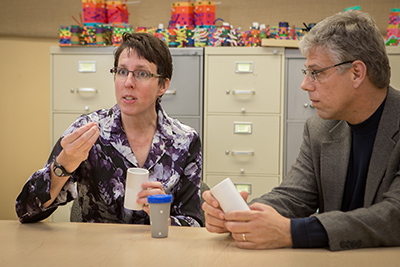
Jun 13, 2014
Patent on gag-reflex reduction device granted to Miami

Donna Scarborough and Michael Bailey-Van Kuren, inventors of a recently patented gag-reflex reduction device, discuss another one of their inventions: a controlled-flow 'sippy" cup.
written by Reid Smith, director of technology transfer & business partnershipsMiami University received word that a patent will be granted on Miami's gag-reflex reduction device. This device, invented by Donna Scarborough (Speech Pathology and Audiology) and Michael Bailey-Van Kuren (Mechanical and Manufacturing Engineering), diminishes the gag reflex in situations where a hyper-sensitive response can interfere with routine health procedures. Currently there is no clinically-tested and approved product for this healthcare problem.
The technology behind the device is a pressure applicator that provides a controlled, specific input to an area of the palm, which in turn has an effect on the nervous system that attenuates the gagging response to stimuli in the oral cavity. The device has been on a commercialization pathway for a number of years, with the business plan having its origin in a Farmer School of Business capstone class. The team assembled to assess and construct an entrepreneurship plan for the invention began the process in 2009, which led to the formation of a company that secured rights to the technology under an option agreement in 2011. The company PharynMed is now in negotiations with the university to secure a license upon having reached the milestone of first patent issuance. The company is also seeking funding to support further development and commercialization of a product under the license.
While the news bodes well for the technology, it also highlights one of the challenges faced by academic institutions, individual inventors, and corporations alike. The original patent filing for the invention dates back to May, 2008. With the recent notice of allowance, the university and the USPTO close a process that required almost six years of activity to bring to conclusion. This fact points to the substantial time and cost involved in pursuing a patent for a technology in the US While some of the individual characteristics of this case and its prosecution history contributed to the lengthy pendency at the USPTO, it is not uncommon for patent applications assigned to certain technology art groups to spend several years in the process queue at the Patent and Trademark office.
Recent changes to US patent law in the Leahy-Smith America Invents Act (2011) were designed to address the problem of lengthy pendency by affording the USPTO new fee setting authority and allowing for a new expedited prosecution option for an additional fee. With the new fast-track or prioritized examination procedures, an applicant has the ability to move an application forward in the queue. This option is available for applications filed on or after September 26, 2011, and is available for original/new utility applications, as well as new continuation applications and plant applications. In the current form, entry to the accelerated track is limited to the first 10,000 requests during any fiscal year, so the demand for the program and the effect on the current backlog of cases remain as factors in reducing pendency time for cases.
According to the USPTO’s patent dashboard, there are approximately 616,000 unexamined cases in the backlog and the traditional total pendency measure (including Request for Continued Examination, or RCE, applications) is 38 months, with first office action pendency at 18.6 months. The number of patent examiners on staff at the USPTO has declined slightly to 7966, since December.
